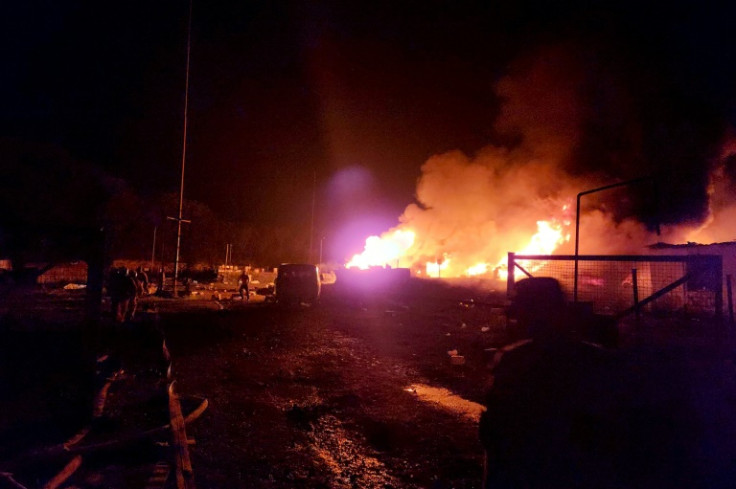Almost 50,000 Nagorno-Karabakh Refugees Have Fled To Armenia
The Karabakh Army agreed to surrender after Azerbaijan launched a 24-hour "anti-terror" military offensive. As a result, ethnic Armenians are fleeing the region.

More than 40,000 ethnic Armenians have fled Nagorno-Karabakh, which amounts to a quarter of the population of the territory that was seized by Azerbaijan last week.
On Tuesday 19 September, the Azerbaijan Armed Forces launched a 24-hour "anti-terror" military offensive that inherently saw the Karabakh Army agree to a surrender. As a result, both sides agreed to a ceasefire while thousands of ethnic Armenians prepared to leave the Nagorno-Karabakh region.
As part of the ceasefire, Russia's Defence Ministry declared that the Armenian separatists would hand their weapons over to the Azerbaijan forces. The weapons include more than 800 guns and six armoured vehicles.
Moscow has also implemented that 2,000 peacekeepers observe the area as the submission takes place.
With thousands of Armenians in the mountainous region witnessing serious food shortages, fuel and electricity, the International Committee of the Red Cross (ICRC) arrived in Karabakh on Saturday with an aid convoy.
In a statement, the ICRC said that the humanitarian aid convoy had carried 70 metric tonnes of supplies along the only road link between Armenia and Karabakh - the Lachin corridor.
This is how ethnic cleansing looks like in #Artsakh/#Karabakh. Armenians who lived there for over 2,000 years are now forced by #Azerbaijan Republic (#Baku) to leave #Stepanakert. They were starved for months and bombed for days by Azeri Armed Forces. pic.twitter.com/V3n8lNOJDK
— Babak Taghvaee - The Crisis Watch (@BabakTaghvaee1) September 26, 2023
Russia also claimed that it had delivered more than 50 tons of food and other humanitarian supplies to Karabakh, where 17 people were wounded during the fighting.
It has been estimated that between 19,000 to 120,000 ethnic Armenians have fled their homes to Armenia and other regions. Sources witnessed many people making their way across the border in crammed open-topped trucks and on tractors.
TASS, a Russian news agency, quoted Deputy Prime Minister Tigran Khachatryan saying that hundreds of cars and busses have also been spotted arriving in Armenia.
One elderly woman noted that the 77km (48-mile) drive had taken 24 hours, on which, they had eaten no food.
Hundreds of people were also reported to be panic buying fuel amid the journey.
On Monday 25 September, at least 68 people were killed and more than 300 people were injured after a fuel storage facility blew up during their mission to seek refuge in Armenia.
Since the massive blaze, 105 people have been reported missing.

During the mass flee, the Azerbaijani authorities announced that they were scouring the area for suspects who had committed "war crimes", with one government source telling Agence France Presse that Azerbaijan intended to carry out an "amnesty to Armenian fighters who laid down their arms in Karabakh".
"But those who committed war crimes during the Karabakh wars must be handed over to us," the government spokesperson added.
In Armenia, the authorities have arranged a bus service to evacuate the thousands of refugees to other towns and villages. Local volunteers have also handed out basic food items and blankets.
Last week, Malina and her family, including four young grandchildren, told reporters that they spent two days huddling in their cellar as their village was a battlefield.
Malina also informed reporters that soon after the Karabakh forces surrendered, the local authorities told the villagers to seek safety in Armenia.
Like thousands of other refugees, Malina recalled that her family left Nagorno-Karabakh because, despite the reassurance, they would never feel comfortable under Azerbaijani rule.
Yesterday, on Tuesday 26 September, the US Secretary of State Antony Blinken urged Azerbaijan's President Ilham Aliyev to allow "unhindered humanitarian access to Nagorno-Karabakh", in order to provide "unconditional protections and freedom of movement for civilians".
Ethnic Armenian leaders have reported that those who remain in the Karabakh enclave are without food and shelter, sleeping in abandoned school buildings, basements or on the streets.
In response, the Armenian Health Ministry announced that it would be sending helicopters to evacuate patients from the region's hospitals that are currently struggling to keep up.
Azerbaijan also noted that their authorities had sent medical supplies to the strained medical facilities.
© Copyright IBTimes 2025. All rights reserved.





















